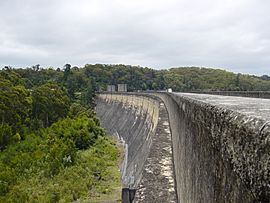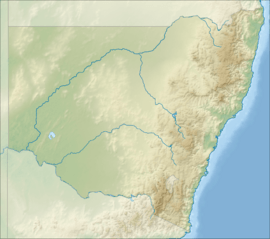Cordeaux Dam facts for kids
Quick facts for kids Cordeaux Dam |
|
|---|---|

The curved arch dam wall
|
|
|
Location of Cordeaux Dam in New South Wales
|
|
| Location | Cordeaux River, Cordeaux, New South Wales |
| Coordinates | 34°20′07″S 150°45′00″E / 34.3353731497°S 150.7499066490°E |
| Purpose | Potable water supply |
| Status | Operational |
| Construction began | 1918 |
| Opening date | 1926 |
| Construction cost | A£945,000 |
| Operator(s) | Sydney Catchment Authority |
| Dam and spillways | |
| Type of dam | Arch dam |
| Impounds | Cordeaux River |
| Height (foundation) | 58.2 metres (191 ft) |
| Length | 709 metres (2,326 ft) |
| Elevation at crest | 303.6 metres (996 ft) AHD |
| Width (crest) | 5 metres (16 ft) |
| Width (base) | 45.7 metres (150 ft) |
| Reservoir | |
| Creates | Cordeaux Reservoir |
| Total capacity | 93,716 ML (20,615×106 imp gal; 2.4757×1010 US gal) |
| Surface area | 782 hectares (1,930 acres) |
| Maximum water depth | 51.8 metres (170 ft) |
| Official name | Cordeaux Dam |
| Type | State heritage (built) |
| Criteria | a., b., c., d., e., f., g. |
| Designated | 18 November 1999 |
| Reference no. | 1360 |
| Type | Water Supply Reservoir/ Dam |
| Category | Utilities - Water |
| Builders | Department of Public Works |
The Cordeaux Dam is a special dam in Cordeaux, Australia. It provides drinking water to many areas. These include Macarthur, Illawarra, the Wollondilly Shire, and Sydney. It is one of four dams that are part of the Upper Nepean Scheme. This scheme helps supply water to a large part of New South Wales.
The dam was finished in 1926. It was built under the guidance of Ernest Macartney de Burgh. Water NSW, a government agency, now owns and operates it. The dam is so important that it was added to the New South Wales State Heritage Register in 1999.
Contents
How Was Cordeaux Dam Built?
The Cordeaux Dam is an arch dam built across the Cordeaux River. It is about 58 meters (191 feet) high and 404 meters (1,327 feet) long. The dam creates a large lake that can hold about 93,640 megalitres of water. Building the dam started in 1918 and finished in 1926. It cost about A£945,000 at the time.
The dam wall is made of huge sandstone blocks. These blocks were dug up right at the building site. They were then cemented together. The outside of the dam is covered with a mix of bluestone and sandstone concrete.
What Made Cordeaux Dam Special?
Cordeaux Dam had some cool new features compared to older dams like Cataract Dam.
- It had special joints that allowed the dam to expand and shrink a little. This helped prevent cracks.
- There were special tunnels inside the dam called inspection galleries. Engineers could walk through these to check the dam's condition.
- Pipes were also put in to measure any water pressure from the ground.
The materials for the dam came from far away. The blue metal (a type of rock) used in the concrete came from quarries in Kiama. It was brought by train to Douglas Park. From there, it traveled by a special ropeway across the Nepean Gorge. Then, a small steam train carried it to the dam site.
The History of Cordeaux Dam
The idea for the Upper Nepean Scheme started in 1880. People realized that Sydney needed more water than the old system could provide. The Nepean project involved building weirs (small dams) to collect water from the Cataract, Cordeaux, Avon, and Nepean rivers. This water was then sent to the Prospect Reservoir.
Who Designed and Built the Dam?
The New South Wales Public Works Department designed and built Cordeaux Dam. Many skilled engineers worked on the project. These included Cecil Darley, Leslie Wade, Henry Dare, and Ernest M. de Burgh. The dam's success shows how talented these engineers were. It still works today, providing water to many homes and businesses.
What Does Cordeaux Dam Look Like?
Cordeaux Dam is built from large sandstone blocks. These blocks weigh between two and four and a half tons. They were set in cement mortar. The front of the dam, facing the water, is covered with strong basaltic stone concrete. The back of the dam is covered with sandstone concrete.
The dam wall is curved. It also has a spillway, which is a channel for excess water to flow out. At each end of the dam wall, there are large, decorative towers called pylons. These pylons look like ancient Egyptian buildings. They have special fluted (grooved) columns.
There are also two small buildings along the dam wall called valve houses. These are square, flat-roofed concrete buildings. They also have an Egyptian style with sloped walls and overhanging roofs. These houses contain the pipes and valves that control the water flow. There are also two similar valve houses at the bottom of the dam wall.
Key Facts About Cordeaux Dam
- Total water it can hold: about 93,716 megalitres.
- Deepest part of the water: about 51.8 meters (170 feet).
- Tallest part of the wall: about 58.2 meters (191 feet) above its base.
- Length of the top of the dam: about 404 meters (1,327 feet).
- Size of the lake: about 782 hectares (1,931 acres) when full.
- Finished in 1926.
- Cost: A£945,000.
- Amount of concrete in the wall: about 215,100 cubic meters (281,440 cubic yards).
- Length of the spillway: about 152 meters (500 feet).
- Width of the top of the dam: about 5 meters (16.5 feet).
- Width of the base of the dam: about 45.7 meters (150 feet).
Water from Cordeaux Dam flows into the Cordeaux River. It then goes to Pheasants Nest Weir on the Nepean River. From there, it travels through tunnels to the Cataract River. Finally, it reaches the Upper Canal, which carries it to Prospect Reservoir.
Buildings at the Dam Site
There are three cottages at the dam site. Two are made of brick and one is made of wood. The brick cottages were built in the 1960s. The wooden cottage seems to be from when the dam was built. It was likely where the Resident Engineer lived. It has a nice front porch that wraps around the side.
Visiting Cordeaux Dam
The Cordeaux Dam is a popular place for visitors. There are picnic areas, pretty gardens, and walking paths. Many of the garden features are from the 1930s. These include stone walls, special picnic shelters, and different types of trees. There's even an avenue of Monterey Pines. The site is well-maintained and beautiful.
How is the Dam Doing Today?
As of 2009, Cordeaux Dam was in very good condition. It has been well-maintained over the years.
- In the 1960s, two new brick cottages were built.
- In 1988, the dam was updated with a new drainage system inside the wall and foundations.
Cordeaux Dam is located in three different council areas: Wollondilly, Wingecarribee, and Wollongong.
Why is Cordeaux Dam Important?
Cordeaux Dam is the second of four major dams built for the Upper Nepean Water Supply Scheme. This scheme is one of Australia's most important engineering projects. Cordeaux Dam still has the longest wall of all the dams in New South Wales.
It was designed by the NSW Public Works Department. This department was led by E.M. De Burgh, a top water supply engineer. Finishing Cordeaux Dam was a big step in making sure Sydney and nearby areas had a steady water supply. Even for its time, Cordeaux was a very large dam. It continues to be a key source of water for the Sydney region.
Its Beautiful Design
Cordeaux Dam is a very good-looking structure. Its strong Egyptian-style architecture fits well with the dam's massive size and the natural beauty around it. The dam site also has old cottages for staff. One of these cottages is a great example of a Federation Bungalow style building.
The public picnic grounds and gardens at Cordeaux Dam are also very special. They still have parts of their original design from the 1920s and 1930s. The landscape design, with its palms, tree ferns, and stone walls, matches the Egyptian style of the dam itself.
A Look at History and Engineering
Cordeaux Dam is important because it shows how water supply systems developed in New South Wales. It was the second dam built in the Upper Nepean catchment area, which has been supplying water to Sydney since the late 1800s. The dam's design and the building methods used show the advanced engineering of the time.
The dam helped Sydney grow a lot in the 1920s and 1930s by providing a reliable water source. The engineers from the Public Works Department, especially Ernest M. de Burgh, showed great skill in completing this project. Even the trees planted by the former Water Board members in 1928 have a special meaning.
Aesthetic and Technical Achievements
The curved wall of Cordeaux Dam is a beautiful engineering work. It fits perfectly within the Cordeaux River valley. The design of the dam's crest houses, entry pylons, and valve houses in the Egyptian style was done by the Government Architect's branch. This style was popular because many Australians had seen Egyptian architecture during military service or learned about it from news reports.
The dam is set in a lovely valley. The lake behind the dam and the steep slopes below create a very scenic view. The old resident officer's cottage is also a great example of the high-quality homes provided for senior staff back then.
Community Connection
Both the National Trust of Australia (NSW) and the Heritage Council of NSW recognize Cordeaux Dam as a very important place. It has historical, architectural, scientific, and social value for everyone in New South Wales.
Learning from the Dam
The way Cordeaux Dam was built, using large stone blocks, is a great example of early dam construction. It shows how advanced the technology was at the time, with its inspection tunnels and drainage systems.
The areas around the dam also show where the construction equipment was located. The upper picnic area was once the site of the construction town. You can still see old road paths and drainage lines from that time. The trees planted for the dam's opening in 1927 also show past gardening practices.
Unique Features of Cordeaux Dam
- The wall of Cordeaux Dam is the longest of all the dams in the Upper Nepean Catchment Area.
- It is one of only three dams in New South Wales with detailed Egyptian-style architecture.
- It's one of two dams in NSW that have special entry pavilions for people and vehicles on the dam wall.
- The dam has original ironwork and machinery that show how water was delivered back then.
- It was the first dam in NSW to have water outlets at different levels and special emergency gates.
- The construction method, using huge stone blocks, is unique to the Metropolitan Dams in Australia.
- It was the first dam in NSW to have internal inspection tunnels and drainage systems.
A Model for Other Dams
Cordeaux Dam is a great example of the type of dam built by the Public Works Department in the early 1900s. Its design features, like the use of different types of concrete and its spillway, are typical of dams from that era.
The way the dam is maintained today, with staff living on site, is also a common practice for dams in NSW. The dam site is also used for public recreation, which is common for many large dams in New South Wales.


